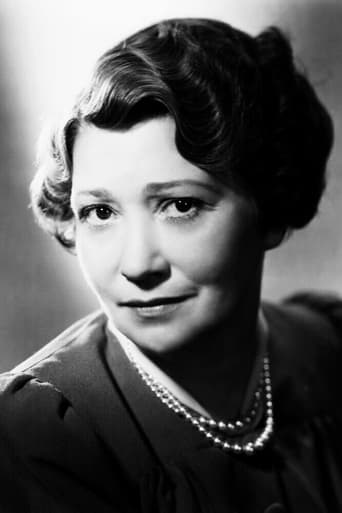VividSimon
Simply Perfect
Kidskycom
It's funny watching the elements come together in this complicated scam. On one hand, the set-up isn't quite as complex as it seems, but there's an easy sense of fun in every exchange.
Forumrxes
Yo, there's no way for me to review this film without saying, take your *insert ethnicity + "ass" here* to see this film,like now. You have to see it in order to know what you're really messing with.
Quiet Muffin
This movie tries so hard to be funny, yet it falls flat every time. Just another example of recycled ideas repackaged with women in an attempt to appeal to a certain audience.
jacobs-greenwood
Directed by Richard Thorpe, with a screenplay by Paul Osborn that was based on the play by Allan Kenward, this nearly all female cast war drama tells the harrowing story of thirteen women on Bataan during World War II just prior to its being overrun by Japanese forces in 1942.Led by two veteran nurses, Lieutenant Mary Smith 'Smitty' (Margaret Sullavan) and Captain Alice Marsh (Fay Bainter), nine novice (e.g. only first aid expertise) volunteers receive on-the-job training (and quinine) to do the best they can to assist the officers with the continuous supply of American G.I. casualties on this precarious peninsula in the Philippine Islands. Connie Gilchrist, who plays the steady cook with a dry wit Sadie, and Marsha Hunt, who plays an already trained civilian that's calm and reasoned under all circumstances, Flo Norris, are the other two women.The volunteers are streetwise Pat Conlin (Ann Sothern), former burlesque stripper Grace Lambert (Joan Blondell), fashion writer from a wealthy family Connie Booth (Ella Raines), attractive brunette Helen Domeret (Frances Gifford), Alabama southern belle with an eye for the "boys" Nydia Joyce (Diana Lewis), virtually invisible Steve Polden (Gloria Grafton), local Luisita Esperito (Fely Franquelli), Andra West (Heather Angel) and her younger sister Sue (Dorothy Morris). Robert Mitchum appears briefly, and uncredited (like all the other characters), as a groaning soldier. References are made to General MacArthur, Corregidor, and President Truman's order to evacuate which supersedes MacArthur's to dig in.Though the film contains a few (unimpressive and requisite) action sequences, the story primarily takes place in the women's bunker, where they sleep and eat; there are a couple of scenes in the outer office of a never seen Lieutenant Thomas Holt (Addison Randall, uncredited does appear with field glasses covering his face near the very beginning), where a communications switchboard is operated by the women. Most of the scenes involve the women talking about their lives, the war, and its effect on themselves, their emotions, and each other.Young Sue West talks about the simplicity of the situation (e.g. what's at stake): if they enemy wins, "we" die; she even says "if one of us dies, all of us will". She's the first to be lost in the first of the ever present air raid(s); she's later found, having lived trapped for four days among dead soldiers in a collapsed structure, such that she's pretty much a shell shocked basket case from then on. Her older sister Andra ends up being the second one to go missing, but later returns to triumphantly tout that she'd shot down an enemy plane when her anti-aircraft gunner "boyfriend" let her "man" the controls.Connie, who'd initially been the biggest "fish out of water" and the most scared of the enemy's continuous bombing raid poundings, ends up growing a spine when a soldier dies in her arms such that she's the first to say she'll stay to the fateful end when the volunteers are given the opportunity (an hour into the film) to participate in a last chance evacuation. Ironically, she's the first to really die when she's strafed while swimming by an opportunistic Japanese pilot. It's also inferred that the enemy intentionally bombed the hospital. Helen, who initially expresses interest in Lieutenant Holt, is a calming influence and a voice of reason among the women while Grace, who laughingly tries to distract everybody's maudlin outlook by demonstrating her striptease act, says some things she shouldn't when her leg is wounded (an injury that magically disappears later).The film's main subplot is relational, and it involves Smitty and Pat. Captain Marsh appears only briefly in a few scenes, including one at the beginning which is confusing until the end and one near the film's conclusion when she (somehow) appears in the bunker just before the voice of the enemy is heard outside. Pat has eyes for Lieutenant Holt, with whom (off-screen) she flirts incessantly to no avail. She's aware the Smitty is also interested in the Lieutenant, but doesn't see the seemingly all business, serious, and even homely nurse as much competition.But Smitty has two secrets: not only is she suffering from malignant malaria (her Captain had wanted to evacuate her to better doctors in Australia even before the volunteers had arrived) but, as a civilian nurse, she'd married Lieutenant Holt; she's able to keep both of these facts from the others until (late in the film) she has an attack and reveals them to Flo, who then relates them to Pat. The film's final scene, after the bunker had been vacated by the others, with their hands above their heads, under orders from an unseen yet English speaking Japanese invader, shows these two women coming to terms with (respect for) one another.
jjnxn-1
As a patriotic exercise in morale rising this film does a good job even though it is downbeat but as an opportunity to see an amazing group of actresses gathered together it can't be beat.With its almost totally female cast, a very young Robert Mitchum just starting out is in and out of the picture in about a minute, this is a rare bird indeed. It's closest match would be The Women but unlike that high comedy cat fest this is a grim examination of the bravery of a group of dedicated nurses and volunteers during the seize of Bataan.All the women are terrific but a few stand out. The great Margaret Sullavan in her second to last feature is fantastic as the outwardly tough nurse Smitty who is hiding many secrets. Ann Sothern and Joan Blondell are wisecracking experts and even under these tough conditions manage to brighten their scenes with plenty of snap. Two of the best character actresses the movies ever had, Fay Bainter and Connie Gilchrist, don't have much too do but inject their special touch into their scenes. Each actress gets some type of spotlight moment and that makes this a memorable exercise. While surely actual field hospitals are much tougher than the one shown here the film still doesn't scrimp and try to make this seem glamorous in any way. These women are going through hell and the ending leaves little doubt that their struggles are far from over but that their courage helped to win the war. A fine piece of entertainment.
dogdba
I have seen this movie about a dozen times on TV since I was a wee lad, way before DVR. So, while watching it again on TCM the other night in the scene where the gals are taking a recreational swim - just before they are attacked by an enemy plane (why the enemy wasted ammo on a bunch of bathing beauties is beyond me), Ella Raines appears to have a wardrobe malfunction with her bathing suit top. I re-played the scene several times on DVR and there is definitely some naked right boobage. Connie(Raines) gets shot and killed at the end of the scene. Janet Jackson got off easy. How this scene made it past the censors of the era is amazing.
Fisher L. Forrest
Like I said, any film with Margaret in it is going to give some viewer satisfaction, but this otherwise potentially great film has an insurmountable flaw for me. I refer to the ridiculous "eternal triangle" romantic sub plot involving "Lt. Mary Smith", her non-regulation husband, and one of the volunteer women. If you haven't seen the film, I won't tell you which, despite checking the spoiler box. Probably this silly business was in the original play, but if it wasn't, then Hollywood owes an apology to the movie going public for spoiling this tribute to the nurses and volunteers who served on Bataan in the early days of the Pacific Theatre of War, circa 1941-1942. If you could edit out the foolishness, this would no doubt be a very accurate picture of conditions facing the wounded soldiers and the women and doctors who tried to care for them. I don't know whether the Japanese deliberately bombed hospitals and aid stations, but there is plenty of evidence that such bombings occurred, accidentally or otherwise. Indeed, our own pilots were not completely innocent of such mistakes in various wars. Sometimes non-combatant establishments are poorly identified, but it is pointless to argue these points. War really is Hell, you know.Well, for the good part of the film, we have 13 fine actresses (14 if you include uncredited Anna Q. Nilsson; it might be fun trying to spot her among the "nurses") of various ages from young to middle-aged. Emphasis is on Margaret Sullavan, Marsha Hunt and Fay Bainter for the serious aspects, and on Ann Sothern and Joan Blondell for what Hollywood no doubt regarded as humorous and "romantic" relief. None of them disappoint. You could look on the basic story as "Greek Tragedy", for the fate of Bataan is fore-ordained from the outset. The Japanese are going to win this one for the time being, and the nurses are headed for imprisonment. I hope what another commentator has said about their receiving good treatment is true. It would be one bright spot in the record of treatment of POW personnel by the Japanese in World War II.





